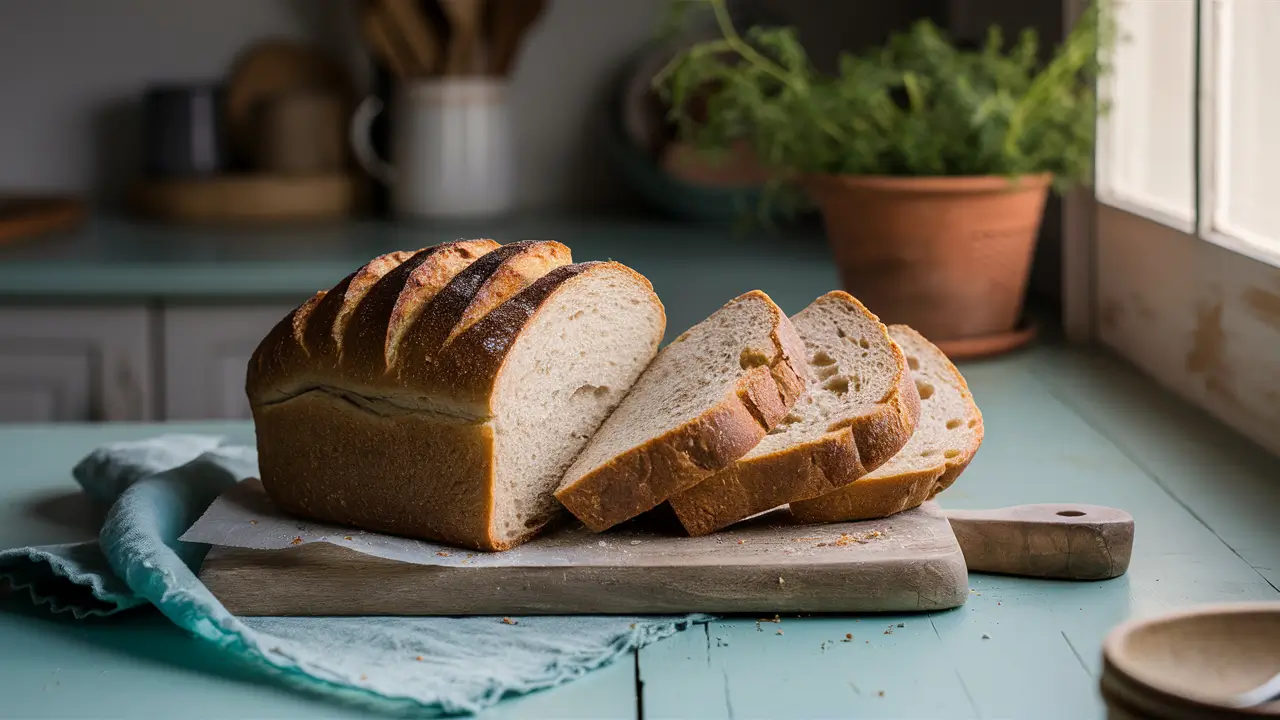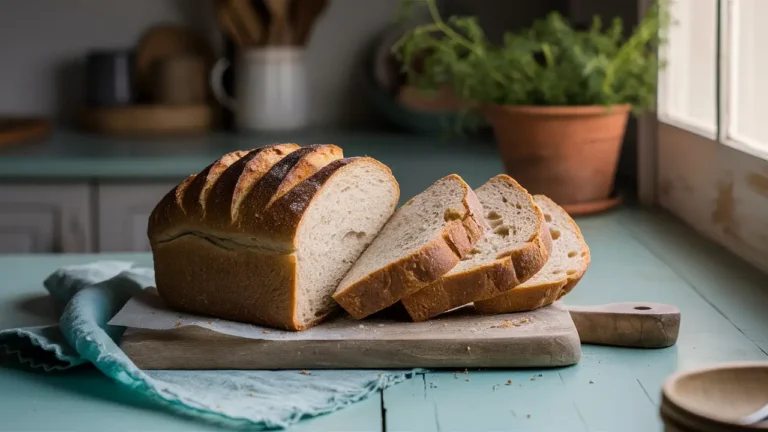Ever wondered how bakers make those amazing sourdough loaves? Now, you can learn to make them yourself! I’ll share my secrets for baking perfect sourdough sandwich bread at home. You’ll learn how to make a tangy loaf with a soft crumb . This bread will make every meal special.

Key Takeaways
- Uncover the secrets to crafting a delicious, homemade sourdough sandwich bread
- Learn the essential techniques and tips for mastering the art of sourdough baking
- Explore the benefits of incorporating sourdough bread into your diet
- Discover how to create a variety of sourdough sandwich bread recipes
- Gain the confidence to bake bakery-quality sourdough bread in your own kitchen
What is Sourdough Sandwich Bread?
Sourdough sandwich bread is a special kind of artisan bread. It’s made with a fermented dough and a sourdough starter. This makes it taste tangy and have a soft, open texture.
Understanding the Artisan Bread
Artisan breads, like sourdough sandwich bread, are made with a lot of care. The dough ferments for 24 hours or more, which creates complex flavors and a chewy texture. Unlike regular bread, sourdough is baked slowly, making it truly special.
Fermented Dough and Natural Leavening
The secret to sourdough sandwich bread is its fermented dough and natural leavening. It uses a special “starter” culture instead of commercial yeast. This starter ferments, producing carbon dioxide. This makes the dough rise naturally, giving it a unique taste and texture.
| Characteristic | Sourdough Sandwich Bread | Commercial Bread |
|---|---|---|
| Leavening | Natural sourdough starter | Commercial yeast |
| Fermentation Time | 24-48 hours | 2-4 hours |
| Flavor | Tangy, complex | Mild, neutral |
| Texture | Chewy, open crumb | Soft, uniform |
The Benefits of Homemade Sourdough Bread
Making your own rustic flavor and texture of sourdough sandwich bread at home has many perks. It’s more than just a fun project. It also brings nutritional advantages that make it a better choice for you and your family.
Rustic Flavor and Texture
The long fermentation process of sourdough bread creates its unique rustic flavor and texture. It doesn’t have the airy, uniform crumb of store-bought bread. Instead, it has a more complex, chewy texture with a delicious crust. This makes any sandwich or meal better, adding depth and character to your homemade bread experience.
Nutritional Advantages
- Increased bioavailability of nutrients: The fermentation process breaks down the bread’s components, making vitamins and minerals more readily available for absorption.
- Lower glycemic index: Sourdough’s slow-digesting carbohydrates help regulate blood sugar levels wich makes it a healthier option for everyone monitoring its intake.
- Improved gut health: The live cultures in sourdough can act as probiotics, supporting a healthy digestive system.
By baking your own sourdough sandwich bread, you get the best of both worlds. You enjoy the unmatched rustic flavor and texture of artisanal bread. Plus, you get the nutritional advantages of a homemade, fermented loaf. This makes your meals better and nourishes your body with the joy of homemade bread.
Sourdough Sandwich Bread
Sourdough sandwich bread is a versatile and delectable option for any meal. It has a crusty exterior, tangy flavor, and soft, open crumb. This makes it perfect for sandwiches, toast, or even enjoyed on its own.
The crusty crust of sourdough sandwich bread is a standout feature. This texture comes from the fermentation process. It makes the dough robust and chewy on the outside. The tangy flavor adds a unique depth, making it a crowd-pleaser.
The open crumb structure is another defining characteristic. This airy interior comes from natural leavening, creating pockets of air. The open crumb enhances the texture and makes it great for sopping up sauces or adding toppings.
| Characteristic | Description |
|---|---|
| Crusty Exterior | The fermentation process gives the bread a robust, chewy crust. |
| Tangy Flavor | The sourdough starter imparts a unique, tangy taste to the bread. |
| Open Crumb | The natural leavening creates an airy, light interior texture. |
Sourdough sandwich bread is a delicious choice for any meal. It’s perfect whether you’re making a hearty sandwich or just want a slice with toppings. This artisanal loaf will satisfy your cravings.
Essential Ingredients for Perfect Sourdough
The secret to a great sourdough sandwich bread is in its ingredients. We’ll look at the two main parts: bread flour and a healthy sourdough starter. These elements combine to make the bread’s unique texture and taste.
Bread Flour and Sourdough Starter
Bread flour is key for a good sourdough crumb and structure. It has more protein than all-purpose flour. This protein helps create a gluten network that traps gases during fermentation. This makes the loaf light and airy.
A strong sourdough starter is also crucial. It’s a mix of wild yeast and good bacteria that makes sourdough bread special. This starter gives the bread its tangy taste and chewy texture. Using natural fermentation makes the bread tasty and better for you than store-bought loaves.
| Ingredient | Purpose |
|---|---|
| Bread Flour | Provides the gluten structure for a light and airy crumb |
| Sourdough Starter | Acts as the natural leavening agent, contributing to the bread’s unique flavor and texture |
Mastering the Bread Baking Process
Making perfect sourdough sandwich bread takes careful attention to the baking steps. From the start to the end, each step is key for the bread’s look and feel. We’ll cover the key techniques to improve your sourdough bread baking skills.
Proofing and Scoring Techniques
Getting the proofing right is vital for the right rise and texture in sourdough bread. The proofing process lets the dough ferment and develop great flavors. It also sets the loaf’s structure. Here’s how to proof your dough well:
- Proof the dough in a warm, draft-free spot for 8-12 hours.
- Check the dough’s size, making sure it has doubled before moving forward.
- Press the dough with your finger to see if it’s ready – it should slowly bounce back.
After proofing, it’s time for scoring. Scoring lets the bread expand and shape during baking, giving it a classic look. Here’s how to score your dough:
- Use a sharp lame or serrated knife for clean cuts.
- Score about 1/4 inch deep, angling the knife for the pattern you want.
- Try different patterns to see what suits your bread baking process best.
Mastering proofing and scoring will help you make beautiful, tasty sourdough sandwich bread every time.
Crafting the Perfect Loaf
The goal of baking sourdough sandwich bread is to make a loaf with a crisp crust and a soft, open crumb. Getting the right crust and crumb needs a mix of techniques and the right conditions. We’ll explore the strategies to make the perfect loaf of sourdough bread.
PrintSourdough Sandwich Bread Recipe
No more store-bought bread for me! (I)_ always feel so accomplished baking my own bread, and the taste is out of this world! Give it a try and let me know how it turns out! #BreadLovers #SourdoughStarter #FreshBread #Foodie #Yum
- Total Time: 13 hours
- Yield: 2 loaves
Ingredients
- Butter (softened) or coconut oil: 1/2 cup (113 g)
- Honey or sugar: 2 tablespoons (42 g for honey or 24 g for sugar)
- Salt: 1 tablespoon (17 g)
- Sourdough starter (active and bubbly): 1 cup (227 g)
- Water (room temperature): 2 1/2 cups (590 g)
- All-purpose flour: 8 cups (1120 g)
Instructions
- Prepare the Dough:
- Add all ingredients to a stand mixer, adding flour last to adjust hydration if needed.
- Knead until the dough is stretchy, smooth, and pulls away from the sides of the bowl (about 10 minutes).
- Perform the windowpane test by stretching a small ball of dough until you can see through it without breaking.
- First Rise:
- Allow dough to bulk rise for 10-12 hours in a warm place. In summer, 8 hours may suffice, while in colder months, it can take longer.
- Shape the Loaves:
- Grease two loaf pans or line them with parchment paper.
- Divide the dough into two equal parts.
- Roll each piece flat into a rectangle and then roll it up into a loaf shape.
- Place the loaves in the prepared pans.
- Second Rise:
- Let the loaves rise for 2-4 hours at room temperature, until doubled in size. This could take as little as 1 hour if the room is warm and the starter is very active.
- Bake:
- Optionally, brush with egg wash for better browning.
- Bake at 375°F (190°C) for 45 minutes, until golden on top.
- Allow to cool completely before slicing.
Notes
- Use very soft butter to ensure it blends easily.
- Avoid over-fermenting to prevent the dough from becoming too wet and sloppy.
- Using a stand mixer can simplify the kneading process.
- Prep Time: 20 minutes
- Category: Bread
- Method: Baking
- Cuisine: American
Nutrition
- Calories: 200 kcal
- Sugar: 2 g
- Sodium: 323 mg
- Saturated Fat: 2 g
- Carbohydrates: 35 g
- Fiber: 1 g
Shaping the Dough for Success
Shaping the dough right is key for the crust and crumb texture you want. Begin by gently degassing the dough to get rid of too much carbon dioxide. Then, fold and turn the dough to make it tight and smooth. This makes the yeast and gluten spread out evenly, giving you a great crumb.
Controlling the Baking Environment
The way you bake your sourdough bread affects its crust and crumb. Try to make a steamy oven by heating a cast-iron pan or baking stone and adding water or ice cubes at the start. This steam makes a crisp, golden-brown crust. Also, adjust the oven temperature and baking time to get the crust and crumb just right.
Cooling and Slicing the Bread
After baking, let your sourdough bread cool down completely before slicing. This helps the crumb set, making it tender and moist. When you’re ready to slice, use a sharp knife to cut it evenly. This will show off the beautiful, open crumb you’ve worked so hard for.
Mastering dough shaping, controlling the baking environment, and cooling the bread right will help you make the perfect loaf of sourdough sandwich bread. Enjoy the fruits of your labor and the delicious, homemade taste of sourdough.
Sourdough Sandwich Bread Variations
The classic sourdough sandwich bread is a favorite, but there’s more to explore. You can play with flavors, add toppings, or try new techniques. The possibilities are endless.
Try adding different grains and flours to your dough for a unique taste. Use whole wheat, rye, or spelt instead of all-purpose flour. Add seeds, nuts, or dried fruits for crunch and sweetness.
For a spicy twist, add aromatic herbs, spices, or roasted garlic to your sourdough. Think about using rosemary, cumin, or turmeric. These can make your bread stand out.
| Sourdough Bread Variation | Ingredients | Flavor Profile |
|---|---|---|
| Seeded Sourdough | Bread flour, sourdough starter, sunflower seeds, flaxseeds, sesame seeds | Nutty, crunchy, hearty |
| Herb-Infused Sourdough | Bread flour, sourdough starter, fresh rosemary, thyme, garlic | Aromatic, savory, earthy |
| Cranberry-Orange Sourdough | Bread flour, sourdough starter, dried cranberries, orange zest | Tart, sweet, tangy |
Sourdough sandwich bread is all about being versatile. Experiment with ingredients, flavors, and techniques to make a loaf that’s uniquely yours. Don’t hesitate to be creative and enjoy the process!
Storing and Enjoying Your Homemade Bread
Making the perfect sourdough sandwich bread is just the start. Keeping your bread fresh and tasty is key. We’ll share tips on how to keep your loaf fresh and ideas for using it in meals and snacks.
Preserving Freshness and Flavor
Keeping your homemade bread fresh and tasty is crucial. Here are some tips for preserving the freshness of your sourdough sandwich bread:
- Let the bread cool down before putting it in an airtight container or bread bag.
- Keep the bread at room temperature, away from sunlight or heat, to prevent drying out or staleness.
- Slicing the bread before storing can help keep it fresh longer.
- If you’re storing the bread for a long time, freeze it. Wrap it well in plastic or foil, and it’ll stay fresh for 3 months.
By following these steps, you can enjoy your homemade bread for days. It will keep its unique flavor and texture.
Incorporating Sourdough Sandwich Bread into Your Meals
Sourdough sandwich bread is great for many meals and snacks. Here are some ways to enjoy your homemade bread:
- Toast it and top it with your favorite spreads, like avocado, nut butter, or a poached egg.
- It’s perfect for a grilled cheese or panini.
- Cut it thick for French toast or bread pudding.
- Add it to a fresh salad for crunch and texture.
- Pair it with soups, stews, or dips for a cozy meal.
Enjoy your homemade sourdough sandwich bread however you like. You’ll love the rich flavors and satisfying texture of artisanal bread.
| Bread Storage Method | Shelf Life |
|---|---|
| Room Temperature | 3-5 days |
| Refrigerator | 5-7 days |
| Freezer | Up to 3 months |
Sourdough Bread for Every Occasion
Versatile and Delicious
Sourdough sandwich bread is perfect for many occasions. It’s great for simple toast or elaborate sandwiches. This artisanal loaf fits any event, showing off its many uses.
The bread’s strong taste and chewy texture are great for many toppings and fillings. It’s perfect for breakfast sandwiches or gourmet lunches. It also works well for entertaining, turning into elegant canapes or perfect pairings for charcuterie and cheese boards.
Sourdough bread is also great for more complex dishes. Its structure and tang are perfect for bread puddings, french toast, and rustic pizza crusts. No matter how you use it, this homemade sourdough will impress everyone, making any event special.
FAQs
What is sourdough sandwich bread?
Sourdough sandwich bread is a special kind of bread. It’s made with a fermented dough and a sourdough starter. This makes the bread taste tangy and have a soft, open texture.
What are the benefits of homemade sourdough bread?
Making sourdough bread at home has many perks. It tastes deep and rustic, and its texture is satisfying. Plus, it’s often more nutritious than store-bought bread because of the fermentation process.
What are the key ingredients for perfect sourdough?
For great sourdough bread, you need quality ingredients. Bread flour and a healthy sourdough starter are key. They work together to give the bread its unique taste and texture.
How do I master the sourdough bread baking process?
To make perfect sourdough, pay attention to every step of the baking process. From proofing to scoring, each step is important for the bread’s look and feel. Learning these steps will help you make a great loaf.
How can I achieve the ideal crust and crumb?
Your goal is a crisp crust and a soft crumb in your sourdough bread. Use the right techniques for shaping and baking to get it just right. This will make your sourdough loaf perfect.
What are some sourdough bread variations I can try?
There are many ways to make sourdough bread your own. Try adding different ingredients, toppings, and techniques to create unique loaves. This lets you make bread that you’ll love.
How do I store and enjoy my homemade sourdough bread?
Storing and enjoying your sourdough bread is important. Use the right methods to keep it fresh and tasty. This way, you can enjoy your homemade bread in many meals and snacks.
How versatile is sourdough bread for different occasions?
Sourdough bread is very versatile. It’s great for simple toast, elaborate sandwiches, and more. Use it in your daily meals and for special events to show off its delicious uses.
Other Recipes You May Also Enjoy
Check out these Easy Meal Prep Ideas to pair with your freshly baked sourdough bread.
Boost your protein intake with this High Protein Meal Prep guide, perfect for a balanced diet.
For a refreshing side, try the Watermelon Feta Salad with Mint, which complements the tangy flavor of the sourdough sandwich bread.
Explore our Quinoa Kale Salad for a nutritious and delicious meal option.
Don’t miss out on this delectable Easy Oreo Cheesecake Recipe for dessert, a perfect ending to your meal.


